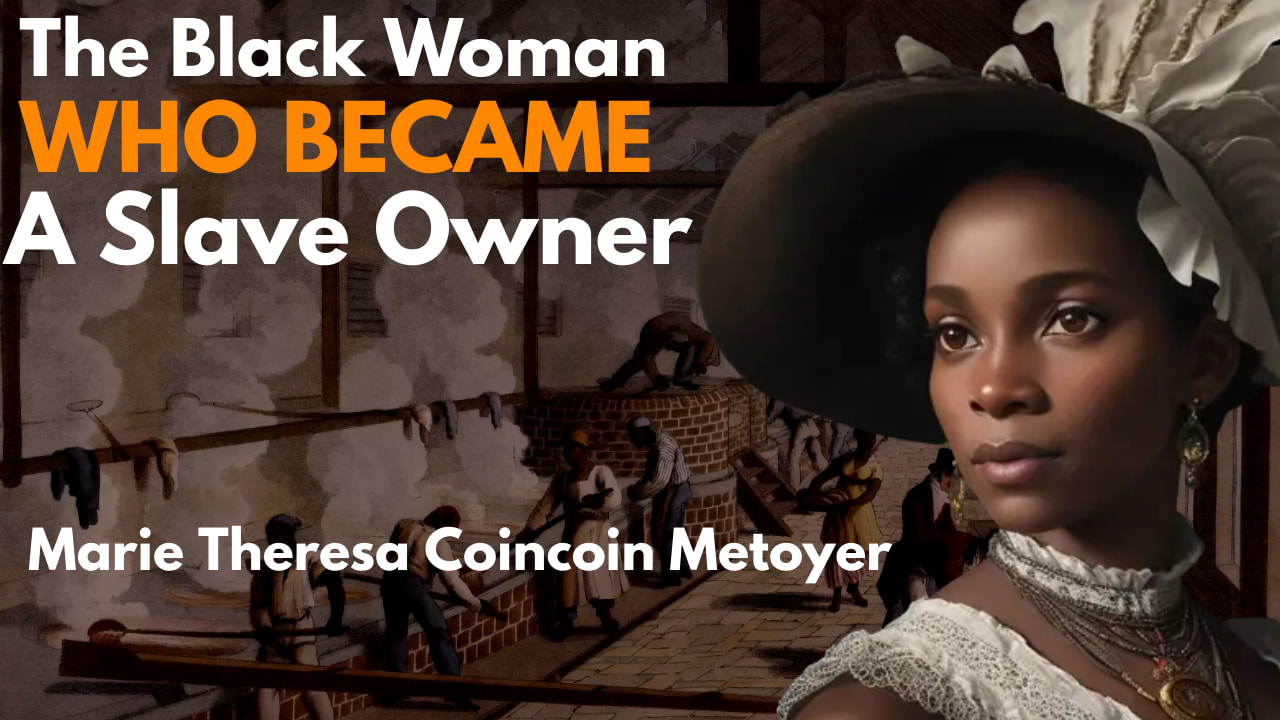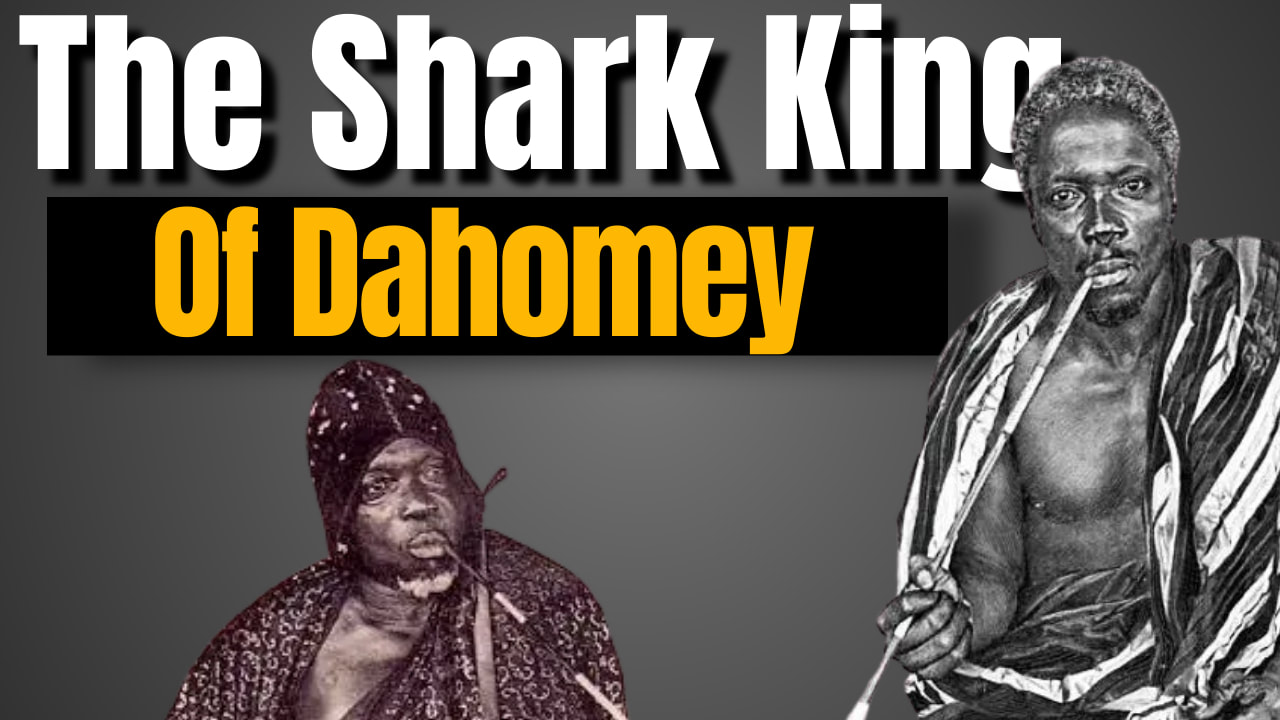|
Marie Theresa Coincoin Metoyer was born in 1742 near Natchitoches, a French settlement in the southern United States, Marie Theresa was of African and Native American descent. Her heritage, unfortunately, made her a victim of racial oppression, and slavery. From a young age, Marie Theresa displayed extraordinary intelligence and a thirst for knowledge, but opportunities for formal education were limited for her and her people. Nonetheless, she learned pharmacology and nursing skills from her parents and her community, growing up deeply appreciating her heritage and culture. By the time Marie became an adult, she was a mother of 5 children and was serving a French Creole family that owned her. Despite the harsh conditions, she remained resilient and resourceful, finding solace in her faith and determination to create a better life for herself and her loved ones. Marie's life took a significant turn when she met Claude Thomas Pierre Metoyer, a wealthy French landowner and merchant. The two developed a strong bond, and despite societal taboos, they began a relationship that defied the norms of the time. Over the years, Marie Theresa and Claude had ten children together, a family that would ultimately play a pivotal role in her life's story. Claude's wealth and influence allowed him to secure freedom for Marie Theresa in 1778, and she became a free woman of color. Marie’s owners wanted to sell her away because of her relationship with Claude. Embracing her newfound freedom, she actively engaged in business and property ventures. Most notably, trapping bears and selling their oils and furs, along with trapping and selling turkeys, indigo, and tobacco. Marie Theresa was a skilled entrepreneur and amassed a substantial estate, eventually becoming one of the most prosperous landowners in Louisiana. But Marie Theresa's ambitions extended far beyond personal success; she sought to secure freedom for her children and their descendants. In a daring and unprecedented move, she convinced Claude to legally acknowledge their children and grant them freedom, ensuring they could lead self-determined lives. By 1788, Marie Theresa and Claude had a massive land grant, and they established a community named Melrose Plantation, which was cultivated and developed by the family. This place would later symbolize African-American history and perseverance in Louisiana. Despite the challenges posed by slavery's persistence in the region, Marie Theresa was instrumental in securing education and vocational training for the African-American community, particularly her own children. She created opportunities for them to gain knowledge and skills that would be essential in the years to come. Marie Theresa Coincoin Metoyer passed away in 1816, leaving behind a profound legacy that has reverberated through the generations. Her descendants would become influential landowners and entrepreneurs, advocating for the rights and welfare of African-Americans throughout the period of American slavery. References: https://www.canerivernha.org/stories/marie-th%C3%A9r%C3%A8se-coincoin https://en.wikipedia.org/wiki/Marie_Th%C3%A9r%C3%A8se_Coincoin
0 Comments
7/17/2023 They Escaped Slavery Using An Ingenious Plan | The Story of William & Ellen CraftRead NowThe daring escape of William and Ellen Craft from slavery is a remarkable and inspiring story of resilience and ingenuity. William and Ellen Craft were both born into slavery in the United States in the early 19th century. They lived in Macon, Georgia, where they experienced the harsh realities and oppression of slavery. Ellen, who was of mixed-race heritage was light-skinned enough to pass as a white person. She was often mistaken for one of her slave master’s legitimate children. William and Ellen devised a daring plan to escape slavery by taking advantage of Ellen’s physical appearance and the stark racial disparities of the time. In December 1848, the couple set their plan in motion. Ellen disguised herself as a young white man by cutting her hair short and dressing in men's clothing. She wrapped a bandage around her face, claiming she had a recent accident, to avoid suspicion. William acted as her personal servant, posing as a slave accompanying his master. Disguised as a wealthy white man traveling with his slave, Williams and Ellen boarded a train in Macon and traveled to Savannah, Georgia. This leg of their journey was fraught with danger, as they had to navigate through checkpoints and interact with fellow travelers they knew very well without revealing their true identities. Their courage and quick thinking were crucial in maintaining their disguise and avoiding suspicion. Upon reaching Savannah, the Crafts boarded a steamship bound for Charleston, South Carolina, where a fellow slave trader offered to buy William from Ellen. After reaching South Carolina, the couple was attempting to buy a ticket to sail to Philadelphia, Pennsylvania. Between buying their tickets and boarding the ship to Philadelphia, the couple was held up by a ticket seller who didn’t want to sign Ellen and William’s names on their tickets. A part of Ellen’s disguise was to pretend her hand was injured. Fortunately, the couple was spotted by the genial captain who vouched for them, so they could board the ship. They chose Philadelphia because it was a prominent center of abolitionist activity and offered a relatively safer haven for fugitive slaves. The journey on the ship tested their nerves, as they had to interact with fellow passengers and avoid arousing suspicion. After a treacherous journey, the Crafts finally arrived in Philadelphia on Christmas Day in 1848. Their escape from slavery garnered widespread attention and admiration from the abolitionist community. William and Ellen settled in Philadelphia, where they became active members of the abolitionist movement, speaking at rallies and sharing their stories to raise awareness about the horrors of slavery. The Crafts' daring escape drew attention to the complexities and contradictions of racial identity and challenged the institution of slavery. Their story became an important narrative in the abolitionist movement and served as a testament to the lengths individuals would go to secure their freedom. The Fugitive slave act was passed in 1850, because of William and Ellen’s popularity, they were targeted by anti-abolitionists to be captured and returned to slavery. Due to the passing of the act, the Crafts packed their bags and moved to London, England where they lived for 19 years. In 1860, the Crafts published a book titled "Running a Thousand Miles for Freedom," recounting their escape and experiences as slaves. The book became a bestseller and helped to further raise awareness about the horrors of slavery and the need for its abolition. The escape of William and Ellen Craft serves as a powerful reminder that our ancestors never stopped fighting for their freedom. William and Ellen Craft, we proudly stand on your shoulders. References: https://www.blackpast.org/african-american-history/craft-william-and-ellen-1824-1900-1826-1891/ https://www.smithsonianmag.com/history/the-great-escape-from-slavery-of-ellen-and-william-craft-497960/ https://en.wikipedia.org/wiki/Ellen_and_William_Craft https://www.amazon.com/Running-Thousand-Miles-Freedom-Editions/dp/0486793486/ref=asc_df_0486793486/?tag=hyprod-20&linkCode=df0&hvadid=312021238077&hvpos=&hvnetw=g&hvrand=17313727770778114229&hvpone=&hvptwo=&hvqmt=&hvdev=c&hvdvcmdl=&hvlocint=&hvlocphy=1015213&hvtargid=pla-517955916164&psc=1 Behanzin Hossu Bowelle, known as the Shark King, was a prominent and fierce figure in the history of the Kingdom of Dahomey. Born in 1844, Behanzin ascended to the throne in 1889, following the death of his father, King Glele. Behanzin’s reign was marked by fierce resistance against French colonial expansion and a determined effort to maintain the independence and sovereignty of his kingdom. He gained the moniker of The Shark King because of his relentless and brave personality. From a young age, Behanzin demonstrated exceptional leadership qualities and military prowess. He received extensive training in warfare and administration, preparing him for the challenges he would face as the ruler of Dahomey. With a strong desire to preserve the traditions and autonomy of his people, Behanzin became a symbol of resistance against the encroaching French forces. In the late 19th century, France intensified its colonization efforts in Africa to expand its empire and control strategic territories. The Kingdom of Dahomey, with its well-organized and disciplined military, posed a significant obstacle to French ambitions. Dahomey's army, along with the Mino warriors, composed of highly skilled female warriors, was particularly feared. Behanzin recognized the threat posed by the French and took measures to defend his kingdom. He fortified strategic positions, upgraded military infrastructure, and trained his troops in modern warfare techniques. Additionally, he sought alliances with neighboring kingdoms, forming a united front against the French expansion. The first major clash between Behanzin and the French occurred in 1890 when a French envoy, led by Captain Archinard, was sent to negotiate a treaty that would effectively transform Dahomey into a French protectorate. Behanzin, unwilling to relinquish his kingdom's sovereignty, rejected the treaty. This rejection began a protracted conflict between Behanzin's forces and the French army. Behanzin's tactics were characterized as guerilla warfare, utilizing the dense jungles and difficult terrain of Dahomey to his advantage. His army employed hit-and-run tactics, ambushing French troops and inflicting heavy casualties. These attacks significantly hampered French progress and frustrated their efforts to conquer Dahomey. Despite his military successes, Behanzin faced increasing pressure from the French, who had superior resources and technological advancements. In 1892, the French launched a full-scale invasion, overwhelming Dahomey's defenses and capturing the capital city of Abomey. Behanzin was forced to flee and continue the resistance from the mountains and forests. The French pursued Behanzin relentlessly, employing a scorched-earth policy to starve the resistance. However, Behanzin continued to lead his forces in guerrilla warfare, refusing to surrender. He skillfully evaded capture which frustrated the French forces at every turn. Ultimately, in 1894, Behanzin's forces suffered a significant defeat at the hands of the French, leading to his capture. Despite his valiant efforts, Dahomey was officially incorporated into French West Africa as a colony, marking the end of Behanzin's reign. Behanzin was exiled to Martinique, a French colony in the Caribbean, where he spent the remainder of his life. Despite his defeat, Behanzin's resistance against the French occupation of Dahomey became a symbol of African empowerment against colonialism. The Shark King will always be remembered as a courageous leader who fiercely defended the independence and sovereignty of his people. His legacy serves as a testament to the enduring spirit of resistance and the fight for freedom against the French. Behanzin Hossu Bowelle, we stand on your shoulders. References: https://realfreeflowingwords.blog/2021/01/16/the-king-shark-behanzin-hossu-bowelle-black-history-365/ https://black-history.fandom.com/wiki/Kondo_%E2%80%9CB%C3%A9hanzin%E2%80%9D_Hossu_Bowelle https://our-ancestories.com/blogs/news/who-was-the-king-shark-of-west-africa Shirley Anita St. Hill Chisholm, known as Shirley Chisholm, was born on November 30, 1924, in Brooklyn, New York. She was an American politician, educator, and author, best known as the first African American woman to serve in the United States Congress and the first African American woman to run for a major party's nomination for President of the United States. Early Life and Education: Shirley Chisholm was the eldest of four daughters born to Charles St. Hill, a factory worker from Guyana, and Ruby Seale, a seamstress from Barbados. Her parents, who were both immigrants, instilled in her a strong sense of pride in her heritage and the importance of education. Chisholm attended public schools in Brooklyn and graduated from Brooklyn Girls' High School in 1942. Chisholm attended Brooklyn College, where she earned a Bachelor of Arts degree in sociology in 1946. She was an active member of various campus organizations and became involved in local politics during college. After graduation, she worked as a nursery school teacher while pursuing a Master's degree in early childhood education from Columbia University. Political Career: Chisholm's entry into politics began in the 1950s when she became involved in the Democratic Party activities in Brooklyn. 1964 she ran for and won a seat in the New York State Legislature, becoming the second African American woman ever elected to the state's legislature. Four years later, in 1968, Chisholm made history by becoming the first African American woman elected to the United States Congress, representing New York's 12th congressional district. During her tenure in Congress, Chisholm was an outspoken advocate for civil rights, women's rights, and social justice. She served on several committees, including the House Agricultural Committee and the Veterans Affairs Committee. In 1972, Chisholm announced her candidacy for the Democratic Party's presidential nomination, making her the first African American woman to seek a major party's nomination for President of the United States. Despite facing numerous challenges and discrimination during her campaign, Chisholm campaigned vigorously and won several delegates at the Democratic National Convention. While she did not secure the nomination, her historic run paved the way for future African American and female candidates. After leaving Congress in 1983, Chisholm taught at Mount Holyoke College and then became a visiting scholar at Spelman College. She also continued to be involved in political and social activism, speaking out on issues such as education reform and gender equality. Legacy and Impact: Shirley Chisholm left an indelible mark on American politics and society. Her unwavering dedication to fighting for the rights of African Americans and women inspired many future generations of politicians and activists. Chisholm's legacy extends beyond her groundbreaking political career. She authored two books, "Unbought and Unbossed" (1970) and "The Good Fight" (1973), in which she detailed her experiences as a congresswoman and offered her perspectives on social and political issues. In 2015, Chisholm was posthumously awarded the Presidential Medal of Freedom by President Barack Obama for her contributions to American society and politics. Her impact on American politics continues to be recognized, with numerous schools, buildings, and programs named in her honor. Shirley Chisholm passed away on January 1, 2005, but her legacy as a trailblazer and champion for equality live on. Her courageous pursuit of justice and equality serves as a reminder of the power of one individual to effect change and reshape. References: https://www.womenshistory.org/education-resources/biographies/shirley-chisholm https://en.wikipedia.org/wiki/Shirley_Chisholm Menelik II was the Emperor of Ethiopia from 1889 to 1913 and is widely regarded as one of Africa's most influential and accomplished leaders. In just over two decades, Menelik successfully modernized and transformed Ethiopia, safeguarding its independence from European colonization and leaving a lasting legacy of progress and unity. One of Menelik's most significant accomplishments was the Battle of Adwa in 1896. Facing the Italian colonial forces, Menelik led his army to a resounding victory, becoming the first African nation to defeat a European colonial power. This triumph not only preserved Ethiopia's sovereignty but also inspired other African countries in their struggle against colonization. Menelik's reign was characterized by a series of modernization efforts. He implemented a number of reforms, including the introduction of a written constitution, the establishment of a modern bureaucracy, a national bank, and the construction of a railway network. Under his leadership, Ethiopia experienced infrastructural advancements, improved education systems, and economic growth. Recognizing the importance of education, Menelik established schools throughout the country and invited foreign educators to contribute to Ethiopia's intellectual development. He also prioritized the expansion of transportation networks, building roads and telegraph lines that facilitated communication and trade. Menelik's policies were aimed at fostering national unity and cultural preservation. He promoted the Amharic language as Ethiopia's official governmental language and encouraged the development of literature, art, and music. His efforts to strengthen Ethiopia's identity and preserve its heritage helped unify diverse ethnic groups within the country. Additionally, Menelik expanded Ethiopia's territory through diplomatic negotiations and military campaigns. He successfully negotiated treaties with neighboring regions and incorporated them into a more significant Ethiopian state, significantly expanding the country's borders. To sum this up, Menelik II's accomplishments were transformative for Ethiopia. His military successes, modernization efforts, and commitment to national unity positioned Ethiopia as a symbol of African resistance to colonization. Menelik's legacy continues to inspire and his reign remains a pivotal period in Ethiopian history. Denmark Vesey was born into slavery in St. Thomas, Danish West Indies around 1767. He was sold to a slave owner in Charleston, South Carolina, and eventually became able to buy his freedom in 1800, and then settled in Charleston, South Carolina, where he became a respected member of the Black community and a successful businessman. In 1816, Vesey began organizing a rebellion against the slave system in Charleston. He and other enslaved people began meeting secretly to plan an uprising. They planned to attack arsenals and armories in the city, seize weapons, and use them to fight for their freedom. Vesey also hoped to gather support from enslaved people on nearby plantations. The uprising was originally planned for July 14, 1822. By this time, Vesey became a well-known and successful carpenter and entrepreneur. Unfortunately, slaves that were loyal to their masters exposed the planned uprising in May of 1822, well before it was set to take place. The authorities arrested Vesey and more than 130 other Black men, many of whom were suspected of being involved in the plot. After a hastily convened trial, Vesey and 34 others were hanged, and 31 more were transported out of the state. The trial and execution of Vesey and his fellow rebels had a significant impact on the history of slavery and the abolitionist movement in the United States. The rebellion and its aftermath became a rallying point for anti-slavery activists and played a role in the growing tensions between North and South that would eventually lead to the Civil War. In the years after the rebellion, Vesey's story became part of the mythology of the abolitionist movement. He was celebrated as a hero and a martyr, and his name became a symbol of resistance and hope for those fighting against slavery. Today, Denmark Vesey is remembered as an important figure in the struggle for Black freedom and a symbol of the power of resistance in the face of oppression. J.A. Ward |
Details
Categories
All
Click Here to join our mailing list
|
Contact Us: |
Connect With Us |
Site powered by PIT Web Design







 RSS Feed
RSS Feed



